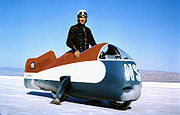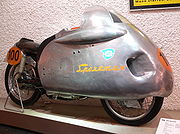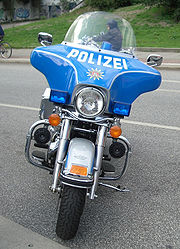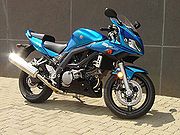
Motorcycle fairing
Encyclopedia


Sport bike
A sport bike, also written as sportbike, is a motorcycle optimized for speed, acceleration, braking, and cornering on paved roads, typically at the expense of comfort and fuel economy in comparison to less specialized motorcycles...
s, with the primary purpose to reduce air drag. The secondary functions are the protection of the rider from airborne hazards and wind-induced hypothermia
Hypothermia
Hypothermia is a condition in which core temperature drops below the required temperature for normal metabolism and body functions which is defined as . Body temperature is usually maintained near a constant level of through biologic homeostasis or thermoregulation...
and of the engine components in the case of an accident. There may be a front fairing, as well as a rear fairing component. A motorcycle windshield may be an integral part of the fairing.
The major benefit of a fairing on sport touring
Sport touring
A Sport touring motorcycle is a type of motorcycle that blends the performance of a sport bike with the long-distance capabilities of a touring motorcycle, while providing comfort and relative safety to the rider....
and touring motorcycle
Touring motorcycle
A touring motorcycle is a type of motorcycle designed for touring. Although any motorcycle can be used to tour with, manufacturers have brought specific models designed to address the particular needs of these riders...
s is a reduction in fuel consumption. The reduction in aerodynamic drag allows for taller gearing, which in turn increases engine life.
History
The importance of streamlining was known very early in the 20th century. Some streamlining was seen on racing motorcycles as early as the 1920s. The effects of aerodynamic drag on motorcycles are very significant.The term fairing came into use in aircraft aerodynamics
Aerodynamics
Aerodynamics is a branch of dynamics concerned with studying the motion of air, particularly when it interacts with a moving object. Aerodynamics is a subfield of fluid dynamics and gas dynamics, with much theory shared between them. Aerodynamics is often used synonymously with gas dynamics, with...
with regard to smoothing airflow over a juncture of components where airflow was disrupted. Early streamlining was often unsuccessful resulting in instability. Handlebar fairings, such as those on Harley-Davidson Tourers, sometimes upset the balance of a motorcycle, inducing wobble. The first factory installed full fairing was that installed on the BMW R100RS introduced in 1976. This marked the beginning of widespread adoption of fairings on sports, and touring types of motorcycles.
Originally the fairings were cowling
Cowling
A cowling is the covering of a vehicle's engine, most often found on automobiles and aircraft.A cowling may be used:* for drag reduction* for engine cooling by directing airflow* as an air intake for jet engines* for decorative purposes...
s put around the front of the bike, increasing its frontal area. Gradually they had become an integral part of the design. Modern fairings increase the frontal area at most by 5% compared to a naked machine. Fairing may carry headlights, instruments, and other items. If the fairing is mounted on the frame, mounting equipment on the fairing reduces the weight and rotational inertia
Inertia
Inertia is the resistance of any physical object to a change in its state of motion or rest, or the tendency of an object to resist any change in its motion. It is proportional to an object's mass. The principle of inertia is one of the fundamental principles of classical physics which are used to...
of the steering
Steering
Steering is the term applied to the collection of components, linkages, etc. which will allow a vessel or vehicle to follow the desired course...
assembly, improving the handling.
Types
- Streamliner: This is a full fairing as found on land speed record machines. The entire body of the motorcycle is covered to provide the lowest drag coefficientDrag coefficientIn fluid dynamics, the drag coefficient is a dimensionless quantity that is used to quantify the drag or resistance of an object in a fluid environment such as air or water. It is used in the drag equation, where a lower drag coefficient indicates the object will have less aerodynamic or...
ratio attainable. The NSU Dolphin II (Delphin II) is a streamliner. - Dustbin fairing: A single-piece, streamlined shell covering the front half of a motorcycle resembling the nose of an aircraft, sometimes referred to as torpedo fairing. It dramatically reduced the frontal drag, but it was banned by Fédération Internationale de MotocyclismeFédération Internationale de MotocyclismeThe Fédération Internationale de Motocyclisme is the governing body of motorcycle racing. It represents 103 national motorcycle federations that are divided into six regional continental unions....
(FIM) from racing in 1958, because it was thought that the frontal point of wind pressure made them highly unstable even with small amounts of yaw. Other reasons cited for the ban were to ensure adequate steering range (lock-to-lock) and stability against crosswindCrosswindA crosswind is any wind that has a perpendicular component to the line or direction of travel. In aviation, a crosswind is the component of wind that is blowing across the runway making landings and take-offs more difficult than if the wind were blowing straight down the runway...
s. FIM regulations forbid streamlining beyond the wheel spindlesAxleAn axle is a central shaft for a rotating wheel or gear. On wheeled vehicles, the axle may be fixed to the wheels, rotating with them, or fixed to its surroundings, with the wheels rotating around the axle. In the former case, bearings or bushings are provided at the mounting points where the axle...
and require the rider's arms and legs to be visible from the side.
- Dolphin fairing: It was called so because in early models the front wheel mud guard streamlined with the rising windshield part of the fairing resembled the dolphinDolphinDolphins are marine mammals that are closely related to whales and porpoises. There are almost forty species of dolphin in 17 genera. They vary in size from and , up to and . They are found worldwide, mostly in the shallower seas of the continental shelves, and are carnivores, mostly eating...
's beak from the side view. They had become the norm since the ban of the dustbins.

- Full-fairing: Bodywork that covers both upper and lower portions of the motorcycle, as distinct from a half fairing, which only has an upper section, and the lower half of the motorcycle is exposed. The fairing on a race or sport bike is meant as an aerodynamic aid, so the windscreen is rarely looked through. If the rider is sitting up at speed he will be buffeted by his rapid progress through the air and act as a parachute, slowing the bike, while if the rider lies flat on the tank behind the windscreen he generates much less aerodynamic drag. The high windscreen and handle-bar width of a touring fairing protect the upright rider from the worst of this, and the windscreen is functional. Full fairings can also provide protection to the engine and chassis in the event of a crash where the fairings, rather than the engine covers and/or frame, slide on the road.

- Half-fairing: Fairing that features a windscreen and fairing extending at least below the handlebars, even as far as down to the sides of the cylinder block, though generally half-fairing doesn't cover the sides of the crankcase or gear box. A number of half-faired models have aftermarket kits available to extend the original half-fairing into a full fairing. Due to the popularity of these kits some manufacturers have started to supply their own full-fairing conversion kits and even offer their half-faired models new with a full-fairing kit fitted at the factory.
- Quarter fairing: A windscreen and minimal fairing extending around the headlight fixed to the triple clamp; also referred to as a "bikini fairing".
- Belly pan: Quarter and half fairings are often paired with a belly pan below the engine for diverting air flow away from under the engine to reduce aerodynamic liftLift (force)A fluid flowing past the surface of a body exerts a surface force on it. Lift is the component of this force that is perpendicular to the oncoming flow direction. It contrasts with the drag force, which is the component of the surface force parallel to the flow direction...
, as well as cosmetic reasons. Some track dayTrack dayA track day is an organised event in which members of the public are allowed to drive or ride around established motor racing circuits, or alternatively on closed or disused airfields...
or racing rules require belly pans to catch leaked fluids.
Materials
Acrylonitrile butadiene styreneAcrylonitrile butadiene styrene
Acrylonitrile butadiene styrene is a common thermoplastic. Its melting point is approximately 105 °C ....
(ABS) plastic is commonly used in original equipment sport bikes and certain aftermarket fairing manufacturers due to its strong, flexible and light weight properties. The advantage of ABS over other plastics is that it combines the strength and rigidity of acrylonitrile and styrene with the toughness of polybutadiene rubber. The proportions of each property vary based on the targeted result.
There are two common methods of producing ABS plastic fairing: injection and compression.
- Injection molds: ABS plastic is melted and injected into mold cavity. Constant pressure is applied to allow for material shrinkage. The plastic then cools and hardens in the mold. Injection molds allows for uniform thickness throughout the entire piece. It gives the most accurate end product that fits well.
- Compression molds: The plastic is generally preheated is placed into a heated metal mold cavity and pressure is applied to force the plastic to contract and take the shape of the mold. Heat and pressure is kept until the plastic cures the mold. The excess plastic is cut away and removed from the mold. Disadvantages to compression mold include varying product consistency and flashing, which is excess material attached to the molded part that needs to be removed where two or more parts of the mold meet.
Fiberglass
Fiberglass
Glass fiber is a material consisting of numerous extremely fine fibers of glass.Glassmakers throughout history have experimented with glass fibers, but mass manufacture of glass fiber was only made possible with the invention of finer machine tooling...
is made of woven fibers, and is used as a reinforcing agent for many polymer products. The composite properly known as glass-reinforced plastic (GRP), is normally referred to by the name of its reinforcing material. Fiberglass fairings are commonly used on the race track. In most cases fiberglass is lighter, and more durable than ABS Plastic. Damaged fiberglass can be repaired by applying new layers of woven fiberglass cloth mixed with a polymer such as epoxy, over the damaged area followed sanding and finishing.
Carbon-fiber-reinforced polymer is the lightest, but most expensive, fairing material. It is used on the most extreme sport and racing motorcycle fairings.

